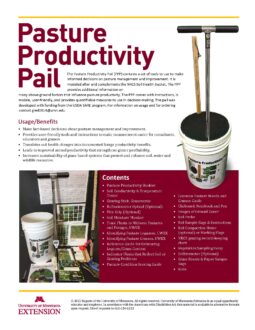The Pasture Productivity Pail (PPP) is a set of tools to help you make informed decisions on pasture management and improvement. Developed with support from a SARE grant, it is modeled after and complements the NRCS Soil Health Bucket. The PPP provides additional information on many above-ground factors that influence pasture productivity.
This PPP is mobile, user-friendly, and provides quantifiable measures to use in decision-making. The tools, instruments, pamphlets, and photos in the PPP can be used to make informed fact-based decisions when completing the NRCS Pasture Condition Score sheet.
The PPP is designed to be used by educators, consultants, and specialists. It can also be used as a teaching tool to educate ranchers and grazers on the finer aspects of pasture management and improvement.
A step-by-step manual is provided to explain the use of each tool in the Pasture Productivity Pail. Everything you need to make your PPP is listed in this handy PPP Materials Guide, including parts and costs. Other useful resources include the 2020 Guide to Pasture Condition Scoring and the 2020 Pasture Condition Score Sheet.
"Graziers need reliable, affordable, and easy-to-use tools to be able to document productivity benefits that come from the adoption of intensive grazing methods and to drive evidence-based decisions," said Rod Greder with the University of Minnesota Extension, who spearheaded the development of the PPP. "Many tools, methods, and protocols exist but are costly, complicated, and not value-added. We compared these approaches so we could develop and recommend a valuable toolkit for North Central region graziers."
Usage/Benefits of the PPP
- Make fact-based decisions about pasture management and improvement.
- Provides user-friendly tools and instructions to make measurement easier for consultants, educators, and grazers.
- Translates soil health changes into documented forage productivity benefits.
- Leads to improved animal productivity that strengthens grazer profitability.
- Increases sustainability of grass-based systems that protect and enhance soil, water, and wildlife resources.
Want more information? See the related SARE grant:
- Evaluating Measurement Techniques of Pasture Productivity to Document Benefits of Enhanced Grazing Systems (LNC16-379)
This material is based upon work that is supported by the National Institute of Food and Agriculture, U.S. Department of Agriculture through the Sustainable Agriculture Research and Education (SARE) program. Any opinions, findings, conclusions, or recommendations expressed in this publication are those of the author(s) and should not be construed to represent any official USDA or U.S. Government determination or policy.
